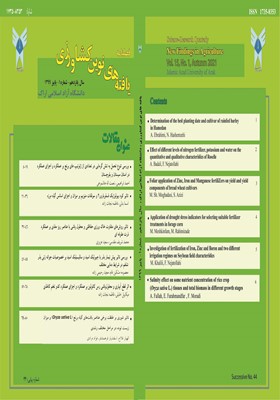اثر قطع آبیاری و محلولپاشی رس کائولین بر عملکرد و اجزای عملکرد کدو تخم کاغذی
محورهای موضوعی : یافته های نوین کشاورزیمیکاییل خلیلی، 1 , فاطمه نجات زاده 2
1 - دانشجوی کارشناسی ارشد فیزیولوژی گیاهان دارویی،ادویه ای و عطری دانشگاه آزاد اسلامی واحد خوی، ایران
2 - عضو هیات علمی گروه کشاورزی، دانشگاه آزاد اسلامی واحد خوی، خوی، ایران
کلید واژه: کائولین, عملکرد دانه, قطع آبیاری, تعرق, کدو تخم کاغذی,
چکیده مقاله :
به منظور بررسی اثر قطع آبیاری و محلولپاشی رس کائولین بر عملکرد و اجزای عملکرد کدو تخم کاغذی آزمایشی در سال 1398 به صورت کرتهای یکبار خرد شده در قالب طرح بلوکهای کامل تصادفی در سه تکرار مورد بررسی قرار گرفت. کرت اصلی شامل قطع آبیاری در چهار سطح آبیاری کامل، قطع آبیاری از مرحله ساقهرفتن، قطع آبیاری از مرحله گلدهی، قطع آبیاری از مرحله پرشدن دانه و کرت فرعی شامل محلولپاشی کائولین در سه سطح عدم مصرف، محلولپاشی کائولین 3 درصد، محلولپاشی کائولین 6 درصد در نظر گرفته شدند. نتایج تجزیه واریانس نشان داد که اثر تیمارهای قطع آبیاری و محلولپاشی کائولین بر تعداد دانه در میوه، عملکرد میوه، وزن هزار دانه، عملکرد دانه و بیولوژیک، شاخص برداشت، درصد روغن و پروتئین، عملکرد روغن و پروتئین معنیدار گردید. بیشترین وزن هزار دانه (55/294 گرم)، عملکرد دانه (2/807 کیلوگرم در هکتار)، درصد روغن (2/46) و عملکرد روغن (3/373 کیلوگرم در هکتار) مربوط به تیمار آبیاری کامل بود. تیمار قطع آبیاری در مرحله ساقه رفتن پایینترین میزان را از لحاظ صفات مورد مطالعه نشان داد. در بین تیمارهای محلولپاشی مواد ضد تعرق نیز بیشترین وزن هزار دانه (07/257 گرم)، عملکرد دانه (7/733 کیلوگرم در هکتار)، عملکرد میوه (84/23 تن در هکتار) در تیمار محلولپاشی کائولین 3 درصد به دست آمد. محلولپاشی کائولین 3 درصد باعث افزایش عملکرد روغن، درصد روغن، درصد پروتئین و عملکرد پروتئین نسبت به تیمار عدم مصرف کائولین گردید. اثر متقابل قطع آبیاری و مصرف کائولین بر هیچ یک از صفات کدو تخم کاغذی معنیدار نگردید. با توجه به نتایج مقایسه میانگین ها، تیمار آبیاری کامل و قطع آبیاری در زمان پر شدن از نظر صفات عملکرد دانه ، روغن و پروتئین در یک گروه آماری قرار دارند و اختلاف معنی داری با هم ندارند و با کاربرد کائولین 3 درصد و قطع آبیاری در زمان پر شدن دانه می توان به عملکرد کمی و کیفی مطلوب در کدو تخم کاغذی دست یافت.
One of the most important and valuable plants in the pharmaceutical industry is the hull-less pumpkin (Cucurbita pepo L. var. Hamedani) plant, which belongs to the cucurbitaceous family. The aim of this research was to evaluate the effect of deficit irrigation and kaolin clay on yield and yield components of (Cucurbita pepo L.). Experiment was laid out as a split plot design with randomized complete block design with three replications at the field located in Siahbaz village, Khoy district, Iran. The main factors included irrigation at four levels (complete irrigation, deficit irrigation from the shoot stage, deficit irrigation from flowering stage, Deficit irrigation from seed filling stage) and sub-factor including three levels of kaolin (control, 3% kaolin, 6% kaolin) was considered. Analysis of variance showed that the effect of deficit irrigation and kaolin on number of seeds per fruit, fruit yield, 1000 grain weight, grain and biological yield, harvest index, oil and protein percentage, oil yield and protein yield were significant. Analysis of variance showed that irrigation treatment at different growth stages had significant effect on leaf number at 1% probability level, but application of kaolin and interaction of irrigation and kaolin on number of leaves per plant was not significant. The results showed that the highest grain weight (294.55 gr), grain yield (807.2 kg/ha), oil percentage (46.2) and oil yield (373.3 kg/ha) were related to complete irrigation treatment. Irrigation at grain filling stage had no significant effect. Deficit irrigation treatment at the stem stage showed the lowest of studied traits. The highest grain weight (257.07 gr), grain yield (733.7 kg/ha) and fruit yield (23.84 kg/ha) were observed in the 3% kaolin spraying treatment. Kaolin 3% increased oil yield, oil percentage, protein percentage and protein yield compared to control treatment. Interaction between deficit irrigation and kaolin consumption was not significant on any of the traits of pumpkin. According to the results of means of oil and protein yield, complete irrigation and cessation of irrigation at filling of grain, were in a statistical group and there was no significant difference with kaolin 3% and cessation of irrigation in filling of grain, the desired quantitative and qualitative yield can be achieved in Pumpkin.
_||_


